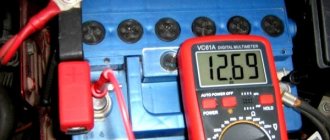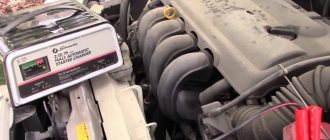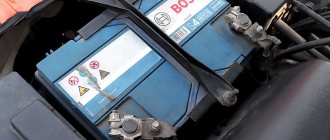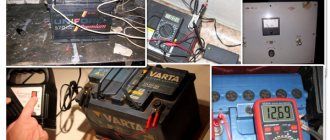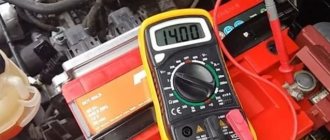Why do you need to quickly discharge a car battery?
Discharging the battery may be necessary if it is necessary to measure the actual internal capacity of the battery. Manufacturers recommend carrying out such manipulations at least once a year, in particular during the transition to winter. Such actions will increase the life of the power source.
When discharging correctly, recovery must be carried out with the set value of the charging current. In this case, the time of discharge reduction is detected, and subsequently the battery capacity is calculated. The calculated value will help to find out the real state of the power source, as well as how much battery capacity is lost.
Causes
Now a few words about the reasons. Often these are all kinds of current leaks. For example, on a stationary car, they should be reduced to zero, but if you install non-standard equipment (alarms, radios, other gadgets), they can suck energy from the battery, even while parked. Here's the first reason.
The car's generator may also shut down, that is, it will not work, the car's charge is being replenished - the second reason.
Third - long-term parking, for example six months or a year, it is recommended to remove the terminal ; if this is not done, the charge may drop to a critical level. In general, you need to start the engine at least once a month to replenish the battery’s energy, and to circulate fluids and oil through its cavities. It is important.
These are probably the main reasons, of course, unless you sit and specifically drain the battery, for example, with a radio or headlights.
Way to drain the battery
There are currently three methods used to reduce battery charge:
- without removing from the car;
- outside of automotive technology;
- use of a multifunctional charger.
Without removing from the car
This method is considered the simplest and most accessible among motorists. The lower threshold of the power source voltage value must be at least 10.3 V, while one bank has a reading of at least 1.7 V. As a result of using this method, the discharge process time is not regulated since on-board consumers are used, each has its own indications of electricity consumption from the battery.
During the discharge process, the following rules must be followed:
- Initially, before discharging the car battery, you must turn off the engine, while the charge will not flow from the generator.
- Turn on on-board electrical consumers. The main devices in almost every car are stoves, radios, and lighting.
- During the entire discharge time, it is necessary to monitor the voltage value at the battery terminals.
- If it drops to 10.3 V, the discharge should be stopped. In this case, restoration is recommended to be carried out immediately.
Advice! With this method of reducing the charge, it is recommended to constantly measure the voltage using a multimeter.
Do not forget that lowering the charge without removing it from the car cannot give a real picture of the internal capacity of the battery. In this case, a discharge is simply carried out to train the power source.
Outside the car
In order to carry out the normal discharge reduction mode and at the same time see the real internal capacity of the power source, it must be removed from the car and discharged separately. The charge is restored afterwards using a special charger. After removing the battery, you need to measure the density of the electrolyte using a hydrometer; the value should be in the range of 1.27-1.29 g/cm3.
To carry out a direct discharge, you should assemble the appropriate circuit:
The voltmeter used will help monitor the voltage as the discharge decreases. Using an ammeter and a variable resistance, it is possible to set the required discharge current. When carrying out a charge reduction for 10 hours, the current value is set to 9% of the internal capacity of the power supply.
Interesting to know! This method can be carried out at home; it is necessary to have measuring instruments and a variable resistance.
In order to determine the capacitance, it is necessary to multiply the current value by the time it takes to reach a reading of 10.3 V. If it is not possible to use a variable resistance, it can be replaced with an ordinary 12 V light bulb, and a consumer of several lamps can be combined. It should be remembered that as a result of the heating of the lamps, non-flammable material should be placed under them. After complete discharge, the power source is set to charging as quickly as possible; this method will help quickly and efficiently establish the normal value of the internal capacity.
Multifunction charger
This method is considered the safest and is recommended by power supply manufacturers. In this case, it is necessary to use a charge-discharge device (CHD) whose design has a discharge function. These devices are used to reduce the charge of acid, lithium and alkaline power sources.
The advantage of this method is that there is no need to constantly monitor the voltage; the device will automatically stop the process. On the device itself, you should set the type of power source and the main parameters by which the charge will be reduced. At the end of the discharge, the device will signal and calculate the actual values of the internal battery capacity. Afterwards, you just need to switch to charging mode and the process of restoring the charge will begin, and the device will indicate the capacity of the restored battery.
Is it possible to restore?
In our world, everything is possible, but at what cost! Ideally, you need to remove the salts from the plus plate, how to do this?
- In case of strong crystallization, physical removal is possible. To do this, you need to remove the plate pack and clean it of salts - then fill in new electrolyte and charge the battery. Is it difficult to do this? YES of course - YES! How do you get a package of plates? You will need to cut the plastic on top and physically pull it out. Then clean each plate separately - this is really difficult to do. Although I have a video somewhere on YOUTUBE, it didn’t really indicate whether the battery then worked or not.
- Of course, now there are a lot of so-called plate desulfators, that is, such chemical liquids remove this deposit of salts, but I will have a separate article about this, here, too, not everything is so simple. Many write that it is simply a miracle, while others never use it. But ideally, the container is also restored and excess salts are removed.
These are the consequences and reasons, by the way, a few words about AGM and GEL, why are they so resistant to deep discharges? It’s simple, here the electrolyte is no longer in the usual liquid state, here it is sealed in double-glazed windows (AGM) or in gel (GEL), so the destructive formation of salts is minimized here, although not completely defeated! There are many times more cycles here, but you shouldn’t let it get to that point either. A short video example.
I’ll finish this, I think it was useful.
Similar news
- How to lubricate battery terminals to prevent oxidation? Plus video
- How to charge a calcium battery. Correct instructions for a...
- TOP5 – Russian batteries. My rating
Add a comment Cancel reply
Control training cycle
Almost every experienced electrician in a car service recommends his clients to use control and training cycles (CTC), as a result of which the service life of the power source is significantly increased. If handled properly and in compliance with safe operation requirements, the battery can last twice as long.
The use of this method helps prevent major problems with the power source. The plates are cleaned of old deposits of sulfuric acid, converted into crystals. Thanks to this, the electrolyte acquires normal density, and the normal working area of the battery electrodes is restored.
If CTC is not carried out, the power source gradually fails. The accumulated salt covers the entire active surface of the battery, preventing it from normal charge recovery.
It is recommended to carry out the control-training cycle at least twice a year during the transition between winter and summer, and the following rules must be observed:
- Correct discharge can only be carried out in compliance with operating requirements and relevant instructions;
- the charge should be reduced only to the lower value of 10.3 V, in this case it is necessary to use special devices, the charge should be restored immediately;
Important! During operation, it is recommended to monitor and promptly turn off devices powered from the on-board network in order to avoid deep discharge of the power source.
Carrying out training activities will significantly extend the service life of the power source. At the same time, observing the necessary requirements and having special instruments, you can calculate the actual internal capacity of the battery.
You may also be interested
.
Batteries 0
Main factors affecting battery performance
During operation, batteries wear out and fail. What can speed up the process, which will lead to a sad fact: your car battery is completely discharged?
- elevated temperature is the cause of corrosion of the plates, as a result of which their active coating is depleted and the electrolyte is depleted;
- electrical overloads - leaving the alarm and telephone on during long periods of parking, standing idle in traffic jams in winter with headlights, a fan, a rear window heater and windshield wipers working simultaneously take more energy than the generator produces. Compressors for inflating tires, brake lights, and a powerful audio system also consume a lot of energy.
- vibration - “bumpiness” slowly but surely shakes off the active substance from the battery plates, so it is especially important to fasten it well and firmly;
- poor care. The battery must be kept perfectly clean - you need to keep the terminals and housing clean, wipe them regularly and monitor the electrolyte level. With an increased density of the electrolyte, the plates will quickly collapse, and with a decreased density, they will sulfate, so the electrolyte will freeze at sub-zero temperatures.
We also recommend reading the article about the types of batteries for cars.
Charge a dead battery in 10 minutes: experiment Kolesa.ru
Here was the story...
The reason for this article was a curious episode that recently happened to a Kolesa.ru journalist, or rather, to your humble servant. About a month ago I bought a middle-aged, but cheap domestic car - as a second one, for slaughter for a dacha construction site.
By the will of circumstances, the car was left for a week practically in the same place where it was bought, and when it was time to move the car to a permanent place of residence, it was discovered that the battery was discharged... It was seriously discharged - the first turn of the key caused a short “whimp” of the starter, the second - a knock of the retractor relay, and the third did not generate even that - only the lights on the “tidy” flickered barely noticeably...
According to the seller, all the electrical wiring of the car was in full working order, the battery was fresh, so it didn’t occur to me to remove the terminal from the battery before idle time. But the interior light remained on, as a result of which the situation turned out to be unpleasant - there were no tools (not even a 10 key to remove the battery!), there were no lighting wires with crocodiles, the car owners whom I approached with a request for lighting the cigarette could not help or they didn’t want to... As a result, I had to turn to the former owner of the car for salvation - fortunately, he lived nearby, and, as it turned out, at that moment he was driving around the area in his new acquisition - a ten-year-old Lancer.
The former owner arrived, but did not bring the cigarette lighter wires - instead, he opened the trunk and took out two dirty and chewed one and a half meter “tails”. One of them was single-core - this is how wiring is done in the walls to sockets, the second was a multi-core cord from an old refrigerator... The cross-section of these “snot” of 1.5–2 square millimeters and the roughly cleaned and darkened from oxides tails did not allow lighting the engine categorically, from the words “absolutely”! However, the situation was resolved favorably - but not at all in the way one might have expected.
The former owner expertly connected the batteries of two cars with these “snots” and, just in case, tried to turn the key - in response, of course, there was not even a click from the starter. After which he winked at me, assuring me that everything would be fine, started his car and relaxed, lighting a cigarette.
My empty battery was charged - the generator voltage was 14.5-14.8 volts - however, as logic and electrical engineering dictate, a completely drained battery would need to be charged in this way for at least several hours! Was my assistant really planning to rattle on until the evening?! This would be quite strange, considering that his wife and child were sitting in the assistant’s car, and we were stretched out, blocking the courtyard passage... However, he was not going to stretch the process to the logically necessary - in no more than 10 minutes (I emphasize - TEN!) the wires were disconnected and wound up, and the first turn of the key started the engine!
What happened?
What happened, at first glance, was incredible... Classical electrical engineering in general and battery science in particular say that a typical lead battery is charged with a current of 10% of its capacity within 10-12 hours. Accordingly, a 55-amp-hour battery, even with a current of 10-15 amperes, had to be filled for at least several hours! However, we “charged” for exactly 10 minutes, and the current clearly did not exceed the above-mentioned value, or even was less - taking into account the thin wires and the disgusting contact of the oxidized wires feebly wound on each other...
That is, it turns out that the effect was not charging, but a kind of “awakening” of a battery that had just fallen into lethargic oblivion. A short ten-minute process could not replenish the energy lost by the battery, but somehow managed to “invigorate” it and helped “mobilize internal resources.” This sounds, I admit, strange: common sense does not approve of such pseudoscientific terminology - “wake up”, “invigorate”... The battery understands only two completely scientific terms - “charge” and “discharge”, and everything else is lyricism...
Mysticism for sale
Lyrics are lyrical, but it is precisely on the above-mentioned effect that Chinese “charging gadgets for blondes” work. Small boxes with a couple of cell phone batteries inside or stuffed with AA format “fingers” - such devices have a cigarette lighter plug coming out of them, and it is through the cigarette lighter that they supposedly charge a dead car battery.
From the point of view of anyone with at least some understanding of electrical engineering, such devices are profanation and deception, but the paradox is that sometimes they are still able to work - in situations similar to the one described above. On a fresh battery – 8-10 volts, on a “magic box” – 12-13. After connecting it to the cigarette lighter, it begins to drive current to the starter battery - the current is weak and completely unable to charge it. But capable of “waking up” and “invigorating”!
Of course, the operation of such devices is extremely unstable, and they will only help if a certain coincidence of factors occurs, which is why they have earned the fair label of fraudulent. But in a number of cases, when the battery itself is fresh and is literally “just about” discharged, even a box of AA batteries stuck in the cigarette lighter can revive it!
How and for how long to charge a battery with constant voltage?
This method can be implemented if the charger is capable of stably maintaining voltage levels within 13.8–14.4V. In this case, the amount of electric current will be determined automatically taking into account the degree of battery discharge, the current temperature state of the electrolyte and other factors.
This technique has the following advantages:
- No electrolyte overheating.
- No excessive release of gases.
- Current readings will never exceed the battery's rated capacity.
- Speed up the charging process.
- There is no need to adjust current indicators, which eliminates the need to remove the battery.
Usually it takes 4-5 hours for the battery to be charged to 90-95%; charging 50-60% can be achieved in just 1 hour. It will not be possible to achieve a full charge due to a lack of voltage at the output contacts of the device.
